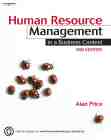Employee Involvement
Adapted from Human Resource Management in a Business Context, 3rd edition (2007)
Ichniowski et al (2000) review a number of theories as to why high skill, high involvement
workplaces are believed to be more effective than traditional 'top-down' management regimes.
They divide these theories into two basic groups:-
1. Those that focus on the effort and motivation of workers and work groups
and suggest that people work harder.
2. Those that focus on changes in the structure of organizations that produce
improvements in efficiency.
In the first group, the emphasis may be:
Working harder. People may work harder if they find elements of a job to be interesting or enjoyable, and this may come
from rewards or feedback. They are also less likely to resent aspects of the job if
have contributed to its design.
Working smarter. Innovative work practices can lead to improved efficiency. Workers can suggest
improved work practices because they have a more intimate knowledge of the job than managers
or external consultants. Moreover, open discussion allows employees to modify their own work
processes to fit more effectively with others as they become aware of the 'bigger picture.' Ichniowski et al point
to the need to change work culture from 'rate-busting' - discouraging high levels of performance - to
one that values greater efficiency. This process can be encouraged by specifically rewarding high performance through collective bonuses.
Theories in the second group may emphasize innovative work practices which can also lead to improvements in organizational structure
that are independent of motivational effects. Ichniowski et al give the following as examples:
* Cross-training and flexible job assignment may reduce the costs of absenteeism.
* Delegating decision-making to self-directed teams can reduce the number of
supervisors or middle managers and improve communication.
* Training in problem-solving, statistical process control, and computer
skils may enhance the benefits of information technology.
* Involving workers and unions in decision-making can reduce grievances and other
sources of conflict.
It is clear that such changes associated with employee involvement are
complex and make it 'difficult to isolate any single causal mechanism that produces their
effects on economic performance.' Nevertheless Ichniowski et al conclude that the companies
which adopt such practices 'should enjoy higher productivity and quality (...), leading to
lower costs and higher product demand, all else equal.' But this comes at a cost because
employee involvement programmes can be expensive due to extra meetings and related activities.
References:
Icniowski, C. Kochan, T.A., Levine, D.I., Olson, C., and Strauss, G. (2000) 'What Works
at Work: Overview and Assessment', in Icniowski, C. Kochan, T.A., Levine, D.I., Olson, C., and Strauss, G. (eds.)
The American Workplace: Skills, Compensation, and Employee Involvement, Cambridge University Press.
This article is based on Human Resource Management in a Business
Context by Alan Price (3rd edition, 2007)
.


